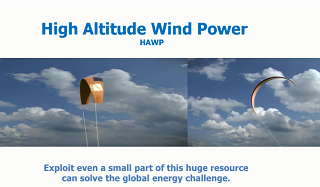High-Altitude Wind: Examining the Merits

There are at least a dozen variations on the theme, but the concept here, in brief, goes like this: energy is extracted from the high-velocity wind aloft as a kite, attached to a cable, is pulled outward from a base that houses a generator. When the cable is fully extended, the kite is moved, via a robot, to a position where the wind is no longer blowing it away from the base, and the cable is retracted, enabling the process to be repeated indefinitely.
Will this generate electricity? Yes. Will it do so cost-effectively? I doubt it. Will it do so as advertised? Absolutely not. The inventors claim an EROI (energy return on energy investment) of 375, which is preposterous. (The average EROI of conventional wind is about 30.)
As always, I’m hoping to be proved wrong, but I can’t imagine that the BOM (bill of materials) and the O&M (operations and maintenance) aren’t going to be stratospheric (pardon the pun).

The rather different approach of Makani (now owned by Google) looks to me to be a more credible effort in this direction, and does not depend on the highly wear inducing process or repeatedly unwinding then winding in a cable. Instead, a “glider like” aeroplane with propellers uses the principles of a computer controlled kite to fly in a repeating circular or figure of 8 pattern at the end of a tether – using the propellers to generate electricity as the “glider” flies into or across the wind (rather like a child running with a toy “windmill”). Power is then transmitted to the ground through the tether.
https://gigaom.com/2013/05/22/google-x-is-acquiring-high-altitude-wind-startup-makani-power/
I think this approach is likely to be far lower maintenance than the kite described.
Note:- A “glider” kite flying in 200 meter circles and having a wind span of 20 meters “sees” the same wind as a wind turbine with a 200 meter sweep less one with a 160 meter sweep. (the same area as a turbine with 60 meter diameter, and possibly capable of generating around a MW of electricity).
If it is flying these circles at 1000 metres altitude, it will also see significantly higher and steadier wind speeds so generating several times as much power as a wind turbine with 60 meter diameter and an 80 meter tower.
A lightweight glider with a 20 meter wing span and a lightweight structure on which to land will use far less materials than a wind turbine of similar rating, and operate at a much better capacity factor. It may however be subject to the need for more frequent maintenance and be made of more expensive materials per kg. Against this, the cost of the generators will be relatively low as the propellers will spin as far higher revs than a wind turbine blade.
Another useful feature of such a system is that it might be possible to fly one into a disaster area using a heavy lift helicopter and very quickly deploy the device to generate several hundred kilowatts of fuel free power to facilitate rescue and recovery efforts – even where the roads are impassible.